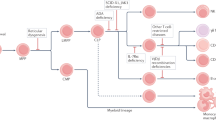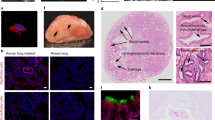Abstract
Vascular leak syndrome is a major and often dose-limiting side effect of immunotoxins and cytokines. We postulated that this syndrome is initiated by damage to vascular endothelial cells. Our earlier studies identified a three–amino acid motif that is shared by toxins, ribosome-inactivating proteins, and interleukin-2, all of which cause this problem. We have now generated a panel of recombinant ricin A chains with mutations in this sequence or in amino acids flanking it in the three-dimensional structure. These have been evaluated alone and as immunotoxins for activity, ability to induce pulmonary vascular leak in mice, pharmacokinetics, and activity in tumor-xenografted mice. One mutant was comparable to the ricin A chain used before in all respects except that it did not cause vascular leak at the same dose and, when used as an immunotoxin, was more effective in xenografted SCID mice.
This is a preview of subscription content, access via your institution
Access options
Subscribe to this journal
Receive 12 print issues and online access
$209.00 per year
only $17.42 per issue
Buy this article
- Purchase on Springer Link
- Instant access to full article PDF
Prices may be subject to local taxes which are calculated during checkout



Similar content being viewed by others
Accession codes
References
Farah, R.A., Clinchy, B., Herrera, L. & Vitetta, E.S. The development of monoclonal antibodies for the therapy of cancer. Crit. Rev. Eukaryotic Gene Expr. 8, 321–356 (1998).
Sausville, E.A. & Vitetta, E.S. Monoclonal Antibody-Based Therapy of Cancer (Marcel Dekker, Boston, 1997).
Frankel, A.E., Kreitman, R.J. & Sausville, E.A. Targeted toxins. Clin. Cancer Res. 6, 326–334 (2000).
Amlot, P.L. et al. A phase I study of an anti-CD22-deglycosylated ricin A chain immunotoxin in the treatment of B-cell lymphomas resistant to conventional therapy. Blood 82, 2624–2633 (1993).
Vitetta, E.S. et al. A phase I immunotoxin trial in patients with B-cell lymphoma. Cancer Res. 51, 4052–4058 (1991).
Stone, M.J. et al. A Phase I study of bolus versus continuous infusion of the anti-CD19 immunotoxin, IgG-HD37-dgA, in patients with B-cell lymphoma. Blood 88, 1188–1197 (1996).
Engert, A. et al. A Phase I study of an anti-CD25 ricin A-chain immunotoxin (RFT5- SMPT-dgA) in patients with refractory Hodgkin's lymphoma. Blood 89, 403–410 (1997).
Messmann, R.A. et al. A phase I study of combination therapy with immunotoxins IgG-HD37-deglycosylated ricin A chain (dgA) and IgG-RFB4-dgA (Combotox) in patients with refractory CD19+, CD22+ B-cell lymphoma. Clin. Cancer Res. 6, 1302–1313 (2000).
Schnell, R. et al. A Phase I study with an anti-CD30 ricin A chain immunotoxin (Ki-4.dgA). Clin. Cancer Res. 8, 1779–1786 (2003).
Sausville, E.A. et al. Continuous infusion of the anti-CD22 immunotoxin IgG-RFB4-SMPT-dgA in patients with B-cell lymphoma: a phase I study. Blood 85, 3457–3465 (1995).
Rosenberg, S.A. et al. A progress report on the treatment of 157 patients with advanced cancer using lymphokine-activated killer cells and interleukin-2 or high-dose interleukin-2 alone. N. Engl. J. Med. 316, 889–897 (1987).
Schindler, J., Sausville, E., Messmann, R., Uhr, J.W. & Vitetta, E.S. The toxicity of deglycosylated ricin A chain-containing immunotoxins in patients with non-Hodgkin's lymphoma is exacerbated by prior radiotherapy: a retrospective analysis of patients in five clinical trials. Clin. Cancer Res. 7, 255–258 (2001).
Senderowicz, A.M. et al. Complete sustained response of a refractory, post-transplantation, large B-cell lymphoma to an anti-CD22 immunotoxin. Ann. Intern. Med. 126, 882–885 (1997).
Soler-Rodriguez, A.M., Ghetie, M.A., Oppenheimer-Marks, N., Uhr, J.W. & Vitetta, E.S. Ricin A-chain and ricin A-chain immunotoxins rapidly damage human endothelial cells: implications for vascular leak syndrome. Exp. Cell Res. 206, 227–234 (1993).
Baluna, R., Rizo, J., Gordon, B.E., Ghetie, V. & Vitetta, E.S. Evidence for a structural motif in toxins and interleukin-2 that may be responsible for binding to endothelial cells and initiating vascular leak syndrome. Proc. Natl. Acad. Sci. USA 96, 3957–3962 (1999).
Coulson, B.S., Londrigan, S.L. & Lee, D.J. Rotavirus contains integrin ligand sequences and a disintegrin-like domain that are implicated in virus entry into cells. Proc. Natl. Acad. Sci. USA 94, 5389–5394 (1997).
Baluna, R. & Vitetta, E.S. An in vivo model to study immunotoxin-induced vascular leak in human tissue. J. Immunother. 22, 41–47 (1999).
Baluna, R., Coleman, E., Jones, C., Ghetie, V. & Vitetta, E.S. The effect of a monoclonal antibody coupled to ricin A chain-derived peptides on endothelial cells in vitro: insights into toxin-mediated vascular damage. Exp. Cell Res. 258, 417–424 (2000).
Press, O.W., Vitetta, E.S., Farr, A.G., Hansen, J.A. & Martin, P.J. Evaluation of ricin A-chain immunotoxins directed against human T cells. Cell. Immunol. 102, 10–20 (1986).
Shen, G.-L. et al. Evaluation of four CD22 antibodies as ricin A chain-containing immunotoxins for the in vivo therapy of human B-cell leukemias and lymphomas. Int. J. Cancer 42, 792–797 (1988).
Ghetie, M.A. et al. Antitumor activity of Fab′ and IgG-anti-CD22 immunotoxins in disseminated human B lymphomas grown in mice with severe combined immunodeficiency disease: effect on tumor cells in extranodal sites. Cancer Res. 51, 5876–5880 (1991).
Soler-Rodriguez, A.M., Uhr, J.W., Richardson, J. & Vitetta, E.S. The toxicity of chemically deglycosylated ricin A-chain in mice. Int. J. Immunopharm. 14, 281–291 (1992).
Rosenstein, M., Ettinghausen, S.E. & Rosenberg, S.A. Extravasation of intravascular fluid mediated by the systemic administration of recombinant interleukin-2. J. Immunol. 137, 1735–1742 (1986).
Ghetie, M.-A., Tucker, K., Richardson, J., Uhr, J. & Vitetta, E.S. The antitumor activity of an anti-CD22 immunotoxin in SCID mice with disseminated Daudi lymphoma is enhanced by either an anti-CD19 antibody or an anti-CD19 immunotoxin. Blood 80, 2315–2320 (1992).
Baluna, R., Ghetie, V., Oppenheimer-Marks, N. & Vitetta, E.S. Fibronectin inhibits the cytotoxic effect of ricin A chain on endothelial cells. Int. J. Immunopharm. 18, 355–361 (1996).
Yan, X. et al. Structure-based identification of a ricin inhibitor. J. Mol. Biol. 266, 1043–1049 (1997).
Simpson, J.C., Lord, J.M. & Roberts, L.M. Point mutations in the hydrophobic C-terminal region of ricin A chain indicate that Pro250 plays a key role in membrane translocation. Eur. J. Biochem. 232, 458–463 (1995).
O'Hare, M. et al. Expression of ricin A chain in Escherichia coli. FEBS Lett. 216, 73–78 (1987).
Sambrook, J., Maniatis, T. & Fritsch, E.F. Molecular Cloning: A Laboratory Manual edn. 2 (Cold Spring Harbor Laboratory Press, Cold Spring Harbor, NY, 1989).
Ghetie, V. et al. The GLP large scale preparation of immunotoxins containing deglycosylated ricin A chain and a hindered disulfide bond. J. Immunol. Methods 142, 223–230 (1991).
Knowles, P.P. & Thorpe, P.E. Purification of immunotoxins containing ricin A-chain and abrin A-chain using Blue Sepharose CL-6B. Anal. Biochem. 160, 440–443 (1987).
Fraker, P.J. & Speck, J.C.J. Protein and cell membrane iodinations with a sparingly soluble chloramide, 1,3,4,6-tetrachloro-3α,6α-diphenylglycoluril. Biochem. Biophys. Res. Commun. 80, 849–857 (1978).
Kalbfleisch, J.D. & Prentice, R.L. The Statistical Analysis of Failure Time Data (Wiley, New York, 1980).
Shah, S.A. et al. Anti-B4-blocked ricin immunotoxin shows therapeutic efficacy in four different SCID mouse tumor models. Cancer Res. 53, 1360–1367 (1993).
Shumaker, R.C. PKCALC: a basic interactive program for statistic and pharmacokinetic analysis of data. Drug Metab. Rev. 17, 331–348 (1986).
Acknowledgements
We thank Lien Le, Ming-Mei Liu, Yuen Chinn, Ana Firan, Steve Ruback, and Stephanie Tuggle for exceptional technical assistance. We thank Shannon Flowers and Linda Owens for secretarial assistance and M. Lord for providing the rRTA clone. We are indebted to Jonathan Uhr and John Schindler for helpful comments concerning the manuscript. This work was supported by US National Institutes of Health grant CA-77701 and a grant from the Higher Education Coordinating Board of the state of Texas.
Author information
Authors and Affiliations
Corresponding author
Ethics declarations
Competing interests
The authors declare no competing financial interests.
Rights and permissions
About this article
Cite this article
Smallshaw, J., Ghetie, V., Rizo, J. et al. Genetic engineering of an immunotoxin to eliminate pulmonary vascular leak in mice. Nat Biotechnol 21, 387–391 (2003). https://doi.org/10.1038/nbt800
Received:
Accepted:
Published:
Issue Date:
DOI: https://doi.org/10.1038/nbt800
This article is cited by
-
Reductive Methylation and Mutation of an Anthrax Toxin Fusion Protein Modulates its Stability and Cytotoxicity
Scientific Reports (2014)
-
Antibody-based Therapeutics for the Treatment of Human B cell Malignancies
Current Allergy and Asthma Reports (2013)
-
In vitro and in vivo anti-tumor activities of anti-EGFR single-chain variable fragment fused with recombinant gelonin toxin
Journal of Cancer Research and Clinical Oncology (2012)
-
Letting go
Nature Biotechnology (2007)
-
A CD19-specific single-chain immunotoxin mediates potent apoptosis of B-lineage leukemic cells
Leukemia (2007)



